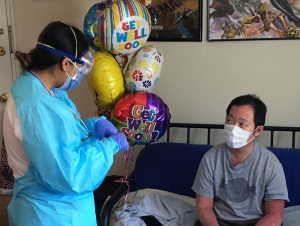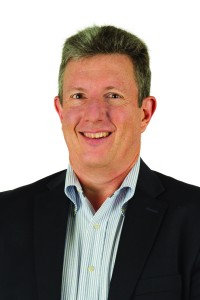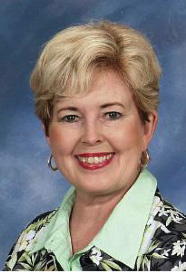
by Steve | Jul 8, 2020 | July-August 2020, Magazine, Magazine Articles

Chris Yuen (right) received a bouquet of balloons during his hospital stay for the coronavirus. Yuen, a 32-year-old member of Midland Park United Methodist Church in New Jersey, spent about 20 days on a ventilator. Photo courtesy of Chris Yuen.
By Sam Hodges –
The Rev. Dunford Cole was too ill with the coronavirus to help with May 31 worship services at the two churches he leads in south Alabama. But he preached anyway via Facebook from his hospital bed the next day.
Fighting for a full breath, choking back tears at times, the 45-year-old pastor of Campground and Rutledge United Methodist churches still managed to lay it on. “Y’all, let me tell you,” he said in a video post viewed more than 41,000 times. “You take care of yourself out there. This thing has been hard, and it’s been bad. And it’s as bad as they claim it to be.” Cole is doing much better and just got home from Crenshaw Community Hospital. His message is the same. “Respect this virus,” he said.
Though some churches have reopened and many are taking steps to do so, the number of COVID-19 cases has risen to about 2 million in the U.S., with 20 states seeing an increase in new cases. Also mounting are the harrowing stories of United Methodists who have been directly affected by the virus.
There have been clergy deaths, including the Rev. Rafael Luna, 61, pastor of a Hispanic United Methodist congregation in Denver; the Rev. Sherrie Dobbs Johnson, 72, a retired Greater New Jersey Conference district superintendent and wife of retired Bishop Alfred Johnson; the Rev. Norm Moyer, retired pastor in the Arkansas Conference; and the Rev. Zosimo Maputi, 67, pastor of Antipolo United Methodist Church in the Rizal Philippines Conference East.
The full extent of COVID-19 clergy and retired clergy deaths is unclear because some conferences are withholding names or cause of death because of privacy concerns and policies. That’s the case in the hard-hit New York Conference. Bishop Thomas Bickerton noted that the conference isn’t always definitively informed of a cause of death. “We estimate around a half dozen pastors and spouses have died (from the virus), and an untold number of parishioners,” he said.
United Methodist laity deaths from the coronavirus include 53-year old nursing home worker Alice Sarupinda in Walsall, England, on April 17. She was part of a Zimbabwean United Methodist congregation in England’s Midlands.
Recovery stories are, thankfully, far more common. Some are dramatic. Chris Yuen, 32, spent 20 days on a hospital ventilator and was nonresponsive much of that time. “A lot of people thought I wasn’t going to make it,” said Yuen, a member of Midland Park United Methodist Church in Midland Park, New Jersey. Yuen rallied, and was able to leave a local hospital on April 22, after almost a month there. “Several nurses and doctors lined up and gave me a cheer on the way out,” he said.
The Rev. Jennifer Stephens, associate pastor at Epiphany United Methodist Church in Loveland, Ohio, came down with the coronavirus in early April. “I’ve been extremely healthy, so it’s shocking to me that the symptoms were as bad as they were,” the 47-year-old clergywoman said. “I’m an avid runner. I eat a plant-based diet.” Stephens eventually tested positive for COVID-19 and was able to recover at home, thanks in part to house calls from a doctor and nurse in her congregation. But she’s still dealing with extreme fatigue and daily headaches, and is concerned about long-term effects.
In early March, the Rev. Kim Strong and his wife, Margo, thought they’d come down with the flu. He felt better after a few days. She felt worse. They couldn’t get her seen at urgent care centers, and they struck out trying to get a virtual visit with a doctor. On the morning of March 17, the situation grew dire. “My wife woke me up and said, ‘I think I’m dying,’” Strong said.
Strong, pastor of Trinity United Methodist Church in Conway, South Carolina, took her to a local hospital, where she was diagnosed with COVID-19 and found to have pneumonia and a blood clot in one lung. Margo Strong, 61, battled back, and was released from the hospital after six days. “I’m very positive if we’d waited another day (to go to the hospital) she would have died,” the pastor said.
Many United Methodists who did not contract the coronavirus themselves have had a loved one who did. That’s the case with Bishop Bickerton. As he has led the New York Conference through the pandemic, the bishop has had to worry about his 84-year-old father in Florida.
Jim Bickerton tested positive for the coronavirus in a nursing home/rehabilitation center in April. Bishop Bickerton and other family members were not allowed to visit — “Heartbreaking,” the bishop said — but did have daily contact through FaceTime.
After weeks of testing positive, Jim Bickerton began to test negative. “The nursing home is all completely negative at this point,” Bishop Bickerton said. “They had 58 cases and 12 people died. For my dad to be one of the survivors is a real blessing for us as a family.”
Sam Hodges is a Dallas-based writer for United Methodist News. Gladys Mangiduyos and Eveline Chikwanah contributed.

by Steve | Jul 8, 2020 | July-August 2020, Magazine, Magazine Articles
 By Max Wilkins –
By Max Wilkins –
The worldwide protests in response to the death of George Floyd in Minneapolis took place during the week that God’s people celebrate Pentecost – the birthday of the Church, the birthday of the mission of Jesus, and the Lord’s sending of Holy Spirit, the Breath of Life.
In massive events all around the globe, activists of all races, creeds, and religions recalled his plea, “I can’t breathe!”
There is a Pentecost message in all of this, and it provides some grounding and some hope.
That first Pentecost took place when the disciples had gathered at Jesus’ direction in a prayer meeting in Jerusalem (see Acts 1:6-11). Also gathered there, just outside the room where they were meeting, were people from every race, every tribe, every language in the known world. “Now there were staying in Jerusalem God-fearing Jews from every nation under heaven. When they heard this sound, a crowd came together in bewilderment, because each one heard their own language being spoken” (Acts 2:5-6).
Immediately upon receiving the promised Holy Spirit, the disciples went out into that gathering and shared this Breath of Life with the people. That very day a Spirit led community formed that included more than 3,000 people – African people, Asian people, Europeans, and Semitic people.
One of the principle purposes of the sending of that Breath of Life was to inspire community and unity (not sameness or negation of culture and distinctiveness, but a unity of spirit, of purpose, of value for life before God).
Jesus was initiating his mission with the coming of the Spirit. “You will receive power,” he had told the disciples, “when the Holy Spirit comes upon you AND you will be my witnesses, in Jerusalem and Judea and Samaria and to the ends of the earth.”
Those recipients of the Breath of Life were sent to bring together communities from all parts of the world, and to recreate that first Pentecost by coming together across lines of division, expectantly anticipating the sharing of the Breath of Life. The mission is to help those who are unable to breathe – physically, spiritually, emotionally – to be able to breathe the Breath of Life. And God’s people can only join that mission by fighting, in prayerful and tangible ways, against the very systemic forces that are crushing the breath out of people.
George Floyd died in Minneapolis, suffocated in broad daylight in front of a crowd. Many people around the country have taken up the cry of “I can’t breathe” in protest of Mr. Floyd’s violent murder and in solidarity with his experience of helplessness in the face of racial injustice.
I recognize, however, that these words are not just the dying gasp of George Floyd. They are also the suffocating cry of millions of people around the world whose necks are being crushed by the systemic evils of racism, of injustice, of economic deprivation, and of indifference. Evil, in its various forms, has been crushing the life out of human beings forever. And evil as it relates to racism, to abuse of power, to white supremacy, and to indifference to the suffering of those outside our own tribe, is particularly virulent right now. It is also totally contrary to the will of God and to God’s plans for the people of God.
Make no mistake, although the issues can be politicized, these are essentially spiritual issues. Some legal justice may occur in this situation. Yet, even if there are criminal convictions in this case, it is only a bandage on a hemorrhage if the inherent injustice built into the system and rampant in our society is not addressed and acted upon in tangible ways. Systems need to change; hearts need to change. And I don’t think that can happen apart from the work of the Holy Spirit in and through his people.
I praise God that by his grace we are a part of his people. Please continue to be instruments of the Breath of Life.
Come Holy Spirit.
Max Wilkins is the president of TMS Global.

by Steve | Jul 8, 2020 | July-August 2020, Magazine, Magazine Articles
 By B.J. Funk –
By B.J. Funk –
I have such sweet memories of my mother, who has been vacationing with Jesus in heaven for 18 years. Imagine my surprise when I recently found an issue of Good News from 1984 among her valuables. Even more precious is her handwritten note on the front: “Read Maxie Dunnam’s article, page 7.”
A personal message from Mama? What beautiful irony that I am now blessed to write for a magazine my mother was reading 36 years ago. I had no idea! I love God’s surprises.
In his article, “You Can Grow in your Walk with God,” Maxie discusses how E. Stanley Jones was so instrumental in renewing his spiritual life. In addition to reading Dr. Jones’ book In Christ, Maxie also attended a Christian ashram. There, at this place of religious retreat, Maxie learned about being the actual dwelling place of Christ.
Searching for deeper meaning, Maxie vividly remembered his experience at the altar as the ashram service ended. Brother Stanley asked if the participants wanted to be whole, adding that the only possibility for wholeness was the indwelling Christ. Dunnam responded with an enthusiastic YES! I nodded my own silent YES!
He began to change his attitude about his Christian life, from that of ministering for Christ to that of allowing Christ to live through him. Jones’ In Christ put Maxie in touch with what would become the central reality of his faith journey: the indwelling Christ. Maxie’s quest for a deeper walk with God brought new life into his personal relationship with Christ. He then wanted his vocational purpose to be helping others develop a deeper walk with God. He developed the following definition of spiritual formation: “That dynamic process of receiving through faith and appropriating through commitment, discipline, and action, the living Christ into my own life to the end that my life will conform to and manifest the reality of Christ’s presence in the world.”
My mother underlined these next words: “Simply put, the task of every Christian is to learn to say yes to Christ in every area of life every day. That’s the bottom line of developing a deeper walk with God.” I was being given a rare and beautiful look into my mother’s sold-out commitment to Christ. She lived before me always the words she underlined.
Maxie, instead of focusing only on the three major ingredients for developing and keeping our faith alive – prayer, Scripture study, and corporate worship – as vital as these are, focused his article on other necessary commitments which don’t receive as much emphasis.
The first is being aware of God’s presence throughout the day. More than only the importance of a daily quiet time, we must develop practices that keep us aware of Christ’s presence. To build awareness, Maxie commits each day to Christ. He visualizes Christ’s presence in every situation he will encounter throughout the day.
Mama carried these thoughts into the Children’s Division of our United Methodist Church, where she served as Superintendent for 35 years.
The second is Christian conferencing, deliberately seeking out and listening to the stories of other Christians. Structured small groups are good for this, as is a spontaneous sharing of our faith.
A third discipline is that of solitude. Maxie wrote that his times of silence are sometimes only a few hours or maybe a 24-36-hour period of silent retreat. The purpose of silent times is not just to talk to God, but to learn how to listen.
Confession and examination of conscience bring important questions to the forefront. “Was I condemning today? Did I speak the truth in love?”
A final discipline is generosity, which includes not only tithing but generosity with our time and attention to others. Recognizing that my mother’s Christian life was enhanced by this article makes me know that I will refer to Maxie Dunnam’s article again and again, wanting to take every word into my own desire for a deeper walk with Christ.
Thank you, Maxie. And thank you, Mama.



 By Max Wilkins –
By Max Wilkins – By B.J. Funk –
By B.J. Funk –